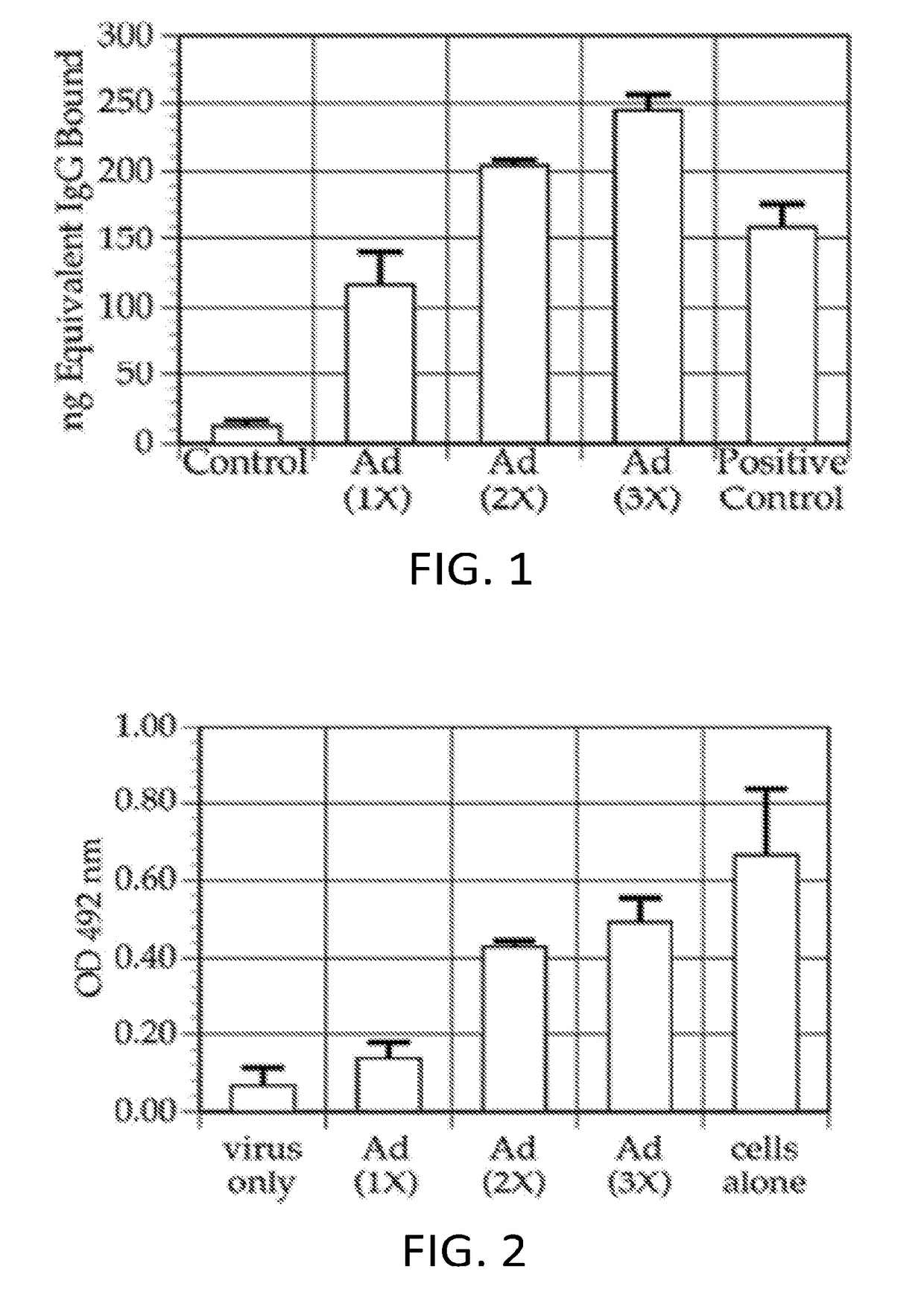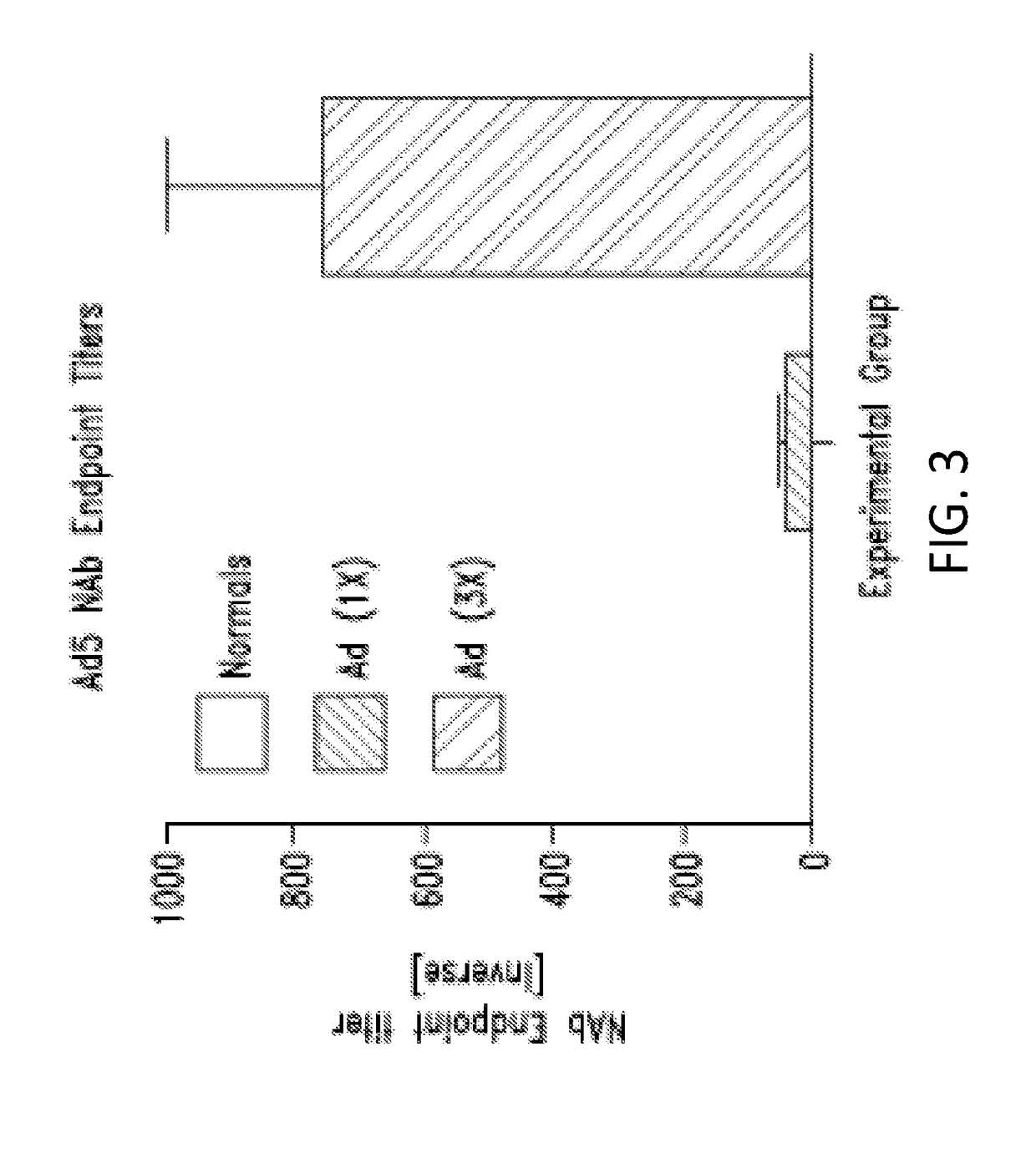Methods and compositions for combination immunotherapy
a combination immunotherapy and composition technology, applied in the direction of drug compositions, peptides, tumor specific antigens, etc., can solve the problems of immunologically potent vaccines, limited strategies, high pre-existing frequency, etc., and achieve the effect of allowing immunization, allowing immunization, and allowing immunization
- Summary
- Abstract
- Description
- Claims
- Application Information
AI Technical Summary
Benefits of technology
Problems solved by technology
Method used
Image
Examples
example 1
Injections of Ad5Null Adenovirus Vector Produces Anti-Adenovirus Antibodies
[0363]This example shows that multiple injections of Ad5-null results in the production of anti-adenovirus antibodies in the injected subjects.
[0364]It was demonstrated that the Ad5-null adenovirus vector that does not contain any heterologous nucleic acid sequences, generated a neutralizing immune response in mice. In one experiment, female Balb / c mice aged 5-7 weeks were immunized with Ad5Null viral particles at 14 day intervals. To determine the presence of anti-adenovirus antibodies, an enzyme linked immunosorbent assay (ELISA) was used. For this ELISA, 109 viral particles were coated onto microtiter wells in 100 μL of 0.05M carbonate / bicarbonate buffer, pH 9.6, and incubated overnight at room temperature. For a standard immunoglobulin G (IgG) reference curve, 200 ng, 100 ng, 50 ng, 25 ng, and 0 ng of purified mouse IgG were coated onto microtiter wells as described above. After incubation, all wells were...
example 2
E1-]-CEA Vector Vaccine Induces CEA Specific Immune Response Upon Re-Immunization in Ad5 Immune Mice
[0369]This example shows that the Ad5 [E1-, E2b-] vector platform induces CMI responses against the tumor associated antigen (TAA) carcinoembryonic antigen (CEA) in the presence of pre-existing Ad5 immunity in mice.
Characterization of Ad5 CEA Vectors
[0370]Initial studies were performed to confirm CEA gene expression of two Ad5-CEA vector platforms.
[0371]It was first determined that the CEA antigen could be expressed on cells transfected with the vaccine vector platforms. A549 cells were obtained from ATCC and transfected with Ad5 [E1-]-CEA or Ad5 [E1-, E2b-]-CEA. Western blot analysis revealed that cells transfected with the vector platforms expressed CEA antigen. (FIG. 35)
Methods
[0372]A549 cells were inoculated at a MOI of 555 VPs / cell with Ad5 [E1-, E2b-]-CEA. Cells were incubated for 48 hours at 37° C. in 5% CO2 After 48 hours cells were harvested and washed with PBS and freeze / tha...
example 3
ive ELISA for CEA Expression on A549 Cells after Infection
[0380]This example shows a dose response evaluation using the Ad5 [E1-, E2b-] CEA vector to transduce the human cancerous lung cell line, A-549. The results show that the CEA antigen can be expressed in a dose dependent manner.
Experimental Design
[0381]On day one, of the assay a BD Falcon Tissue Culture 96-well plate was seeded with A549 cells passaged three days prior (lot#30Jul02, passage p+23), (7.7×103 cells / well) and placed into a 37±2° C. incubator with a 5±2% CO2 atmosphere overnight.
[0382]The next day, a dilution series of the test article were prepared and replicate wells were inoculated at levels ranging from 1.56×103 to 2.5×104 viral particles / well. Untreated A549 cells were used to serve as the mock sample. On day four of the assay wells were treated with a 10% Triton X-100 solution for analysis by ELISA to measure CEA concentration. For the ELISA, a microtiter plate was coated overnight with an anti-CEA capture an...
PUM
| Property | Measurement | Unit |
|---|---|---|
| Fraction | aaaaa | aaaaa |
| Volume | aaaaa | aaaaa |
| Volume | aaaaa | aaaaa |
Abstract
Description
Claims
Application Information
 Login to View More
Login to View More - R&D
- Intellectual Property
- Life Sciences
- Materials
- Tech Scout
- Unparalleled Data Quality
- Higher Quality Content
- 60% Fewer Hallucinations
Browse by: Latest US Patents, China's latest patents, Technical Efficacy Thesaurus, Application Domain, Technology Topic, Popular Technical Reports.
© 2025 PatSnap. All rights reserved.Legal|Privacy policy|Modern Slavery Act Transparency Statement|Sitemap|About US| Contact US: help@patsnap.com



